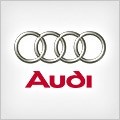
AUDI R8
Generations Timeline, Specs and Pictures
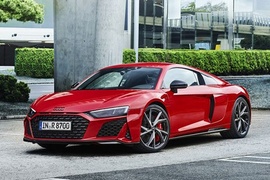
Audi tried the RWD supercar market in 2018 when it launched the R8 RWS, which stood for Rear-Wheel Series.
Even though the carmaker was mostly known for its quattro systems, which sent the power in all corners of a car, it knew that supercars’ drivers were very comfortable with rear-wheel drive vehicles, so it did it. The experiment was successful, and the carmaker continued that by adding the R8 RWD in 2019 and the Performance version in 2021.
From the outside, the car looked very similar to the rest of the R8 range. While the front bumper and general shape of the car were the same, there were a few details different, such as the mate-black singleframe grille, body-colored side air intakes from the rear quarter panels, or the carbon-fiber door-mirror caps. Last but not least, the RWD Performance version received a specific set of light-alloy wheels to lower the unsprung masses.
Inside, a large, sharply contoured arch ran around the driver’s area, creating a “monoposto,” racing atmosphere. In front of the driver, a 12.3-inch display was filled the floating-design instrument cluster. Unlike the rest of the R8 range, the Performance version offered a steering wheel with four control satellites to control the Audi drive select, the start-button, to activate the performance mode, and control the Audi virtual cockpit screen respectively.
Since it was a performance-oriented supercar, it received a new powerplant enhanced by 30 hp when compared to the rest of the range from the same 5.7-liter V10. It was paired as standard with a seven-speed automatic (dual-clutch) gearbox that sent the power to the rear wheels via a mechanical locking differential.
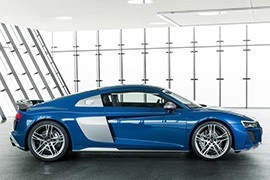
The mid-cycle refresh of the second-generation Audi R8 is not exactly in line with other Audi facelift, since the differences between the old and the new are rather extensive, both on the technical and the visual side.
On the outside, it’s the front end that got the biggest nips and tucks, with the lower fascia now looking more in line with that of the 2018 Audi RS5 and other upcoming RS models.
Both versions of the naturally aspirated 5.2-liter V10 have been improved, with the regular R8 V10 Coupe now delivering 570 horsepower instead of 540 and the R8 V10 Coupe Performance (renamed from V10 Plus) offering 620 horsepower instead of the puny 610 horsepower of its predecessor. A comprehensive redesign of the brakes has improved stopping power on both versions as well.
In 2018, Audi released its first rear-wheel-drive R8, thus the Coupe became the cheapest version of the R8. While cheaper, the car’s weight was also reduced due to the absence of the extra differentials and shafts. The weight was reduced by 40 kg.
The R8 came with standard 19-inch alloys and offered optional ultralight 20-inch milled wheels. Instead of the standard steel discs, customers could opt for ceramic brake discs.
The 2018 model started selling in 2019.
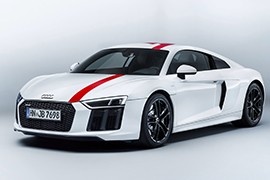
Ever since it launched the concept, Audi was proud of its all-wheel-drive R8 that shook the supercar world and proved to be a serious track-weapon.
In 2017, the R8 made a bolder move.
While most of the supercars evolved from being rear-wheel-drive to all-wheel-drive, the R8 took the opposite path. Audi introduced it as an all-wheel-drive, mid-engine supercar and transformed it into a rear-wheel-drive one. Thus, it silenced the voices which said that a true supercar must have the power sent only to the rear axle. The RWS initials stood for Rear Wheel Series.
The R8 RWS was the least expensive R8 from its times since the customers didn’t have to pay for the front and center differentials. Its bodywork was similar to the regular R8 but with a few small different details. It was underscored by the matte black grille of the singleframe and the matte black air openings at the car’s front and rear. The upper sideblades behind the doors were finished in gloss black, while the lower ones were body-colored. As an option, Audi offered a red strip that crossed the top of the car from the front bumper to the engine’s lid.
Inside, the R8 RWS sported the same interior as the rest of the mid-engined Audi supercar, with sports seats fitted as standard. As an option, the carmaker offered bucket seats. Unlike any of its siblings, it featured a badge on the dashboard which stated the car number, such as “1 of 999.” There was no infotainment screen on the center stack. It was shown inside the instrument cluster on the Audi Virtual Cockpit TFT display.
Behind the two-seat cabin, Audi installed the naturally aspirated 5.2-liter V-10 engine that produced 540 hp. It was paired to a seven-speed automatic (dual-clutch) gearbox. The electronic stability control featured a special drift function.

Despite having a super-car brand in its portfolio, Audi insisted to have its own super-car and, in 2006, it launched the R8, which it was followed by the second generation in 2015.
Audi claimed 13 victories at the 24 hours of LeMans race before launching the second generation of its R8 and that was as much as the Ford and Ferrari combined. It was second only to Porsche. With that kind of sporting pedigree, the four-circle brand could dare and make a bold move with the second generation of the R8. They ditched the V8 engine and manual transmissions. It was time for a new era of supercars.
With its sleek, low profile, and advanced driving post, the second generation of the R8 featured an enhanced aerodynamic profile. On the front side, the new singleframe grille was adorned on the sides by a pair of air scoops for brakes cooling. The side air-intakes for the engine were painted in black, to emphasize the mid-engine design. In the back, under the taillights, there were other air-vents to help to cool the engine and remove the air from the wheel-well.
Inside, the two-seater supercar featured sport-bucket seats and a high-tech interior. With the Audi Virtual Cockpit, the instrument cluster was transformed into a 12.3” display with elaborately computed graphics. The system also showed a shift-light informing the driver when to shift the gears, while in manual mode.
The second generation of the R8 was available with a choice of two V10 engines that offered 540 hp and 610 hp, respectively. The standard transmission was a 7-speed S tronic.
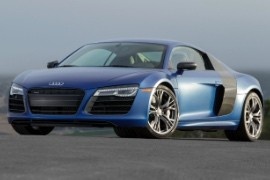
Audi launched its first supercar in 2006, and 2012 brought their new R8 with a 5.2-liter V10 engine borrowed from the Lamborghini Gallardo.
The exterior of the R8 was aggressive, with sharp lines and the Audi’s so called “side blades” on the side (of course). The side blades were made of carbon fiber to maintain a reduced weight. Sticked to the side blades were air intakes that helped redirecting the air to reduce drag.
The headlights were equipped with daytime running LED strips and the R8 was the first car to feature them.
The most interesting part showed the true sports nature of the R8 - the rear-mounted engine with a glass cover.
The 5.2 liter V10 engine developed 525 hp and could rocket the car to 100 kph in 3.7 seconds. The R8 could reach a maximum speed of 318 kph. Quite impressive!
The interior of the R8 didn’t really match the exterior design. It did not give the feeling of being inside a sports car, but rather in an Audi RS.
Sports car usually have different color accents, but the R8’s dashboard was mostly black and simple.
The steering wheel was flat-bottomed as not much space was available in the 2-seater. It was equipped with paddle shifters that looked like aluminium, however, they were made of plastic.
The instrument panel was the classic one, with added V10 and R8 logos on the cluster gauges.
The R8 was a bargain compared to the Lamborghini and still offered a beautiful design, comfort, lots of storage spaces, power and fun.

Audi introduced a mild facelift for its mid-engined supercar in 2012 and made it quicker thanks to a new, seven-speed automatic gearbox.
The R8 was Audi’s flagship among its sports cars. It was a proper supercar developed together with Lamborghini. Worth mentioning that Audi owned the Italian brand, and it shared some parts with it. And that’s how the Italian supercars got more reliable and how the Audi made a big step away from the bland look.
From the outside, the 2012 model was enhanced and featured standard full-LED headlights and taillights. At the front, the single-frame grille with rounded corners at the top was a big statement for the brand’s image. Audi installed a pair of big side-scoops to cool the brakes. On its side, behind the doors, the carmaker installed functional air-intakes for the engine. A carbon-fiber panel enhanced the car’s look, creating a visual distance between the cockpit and the engine bay.
Inside, Audi brought more comfort and luxury items than on the non-facelifted version. A pair of carbon-fiber bucket seats were available on the options list. Fine Nappa leather and carbon-fiber trims were spread around the cabin. But most of the controls and buttons were carried-over from other Audi vehicles, and that spoiled the image of a unique Audi supercar.
The carmaker placed the same V8 engine as its predecessor under the hood but improved it by ten hp. It was paired as standard to a six-speed gearbox. Starting with the 2012 model, the R8 was available with a new, seven-speed automatic (dual-clutch) gearbox.

Audi didn’t wait for the world financial crisis to end and introduced a V-10 version for its R8 supercar using the LeMans race car technologies.
After the German carmaker acquired Lamborghini, it started swapping technologies with the Italian car manufacturer. That resulted in the V-10 powered R8, which featured the same engine as the Gallardo but detuned, so it didn’t compete with the raging bull supercar.
While the V-10 powered R8 looked very similar to its V-8 brother, it featured a few differences. At the front, the massive side-scoops that fed air to the coolers sported two slats instead of four. Also, the single-frame grille featured chromed accents instead of black. An essential upgrade for the headlights was the LED system, a standard feature for the R8-V10. Each headlamp integrated 54 light-emitting diodes, and at 6,000 Kelvin, it resembled the daylight. Behind the cockpit, the rear window grille sported a matte-aluminum look. Last but not least, the front fenders wore a V 10 badge.
The interior looked very similar to its V-8 sibling. It featured the same instrument cluster with a binocular-style panel. In addition, Audi installed the multi-media information (MMI) display connected to the Bang und Olufsen sound system on the center stack. Its leather-clad sport bucket-seats featured high bolstered areas on the sides.
Under the rear windscreen, in a mid-mounted position, Audi installed a 5.2-liter V-10 powerplant longitudinally. Thanks to its direct fuel injection system, it provided 100.9 hp/liter. It was just 31 kg (68 lbs) heavier than the V-8 unit but provided 105 more horses.

Audi may have been the last German premium brand to show a supercar, but when it showed it, they did it properly with the R8 V8 in 2006 at the Paris Auto Show.
After purchasing the Lamborghini supercar brand, Audi thought that they can build something in the same segment. They already had the engines and transmission to do it. All they need was a good platform and a bodywork. In 2003, the Audi showed the “LeMans” concept-car after three consecutive wins at the 24h of LeMans race. Based on that, the Audi made the R8 supercar. It was a light, small, coupe with middle V8 engine and all-wheel-drive.
Inside, there were numerous parts from other Audi models, which were criticized. But the car was true to its image. The 420 hp naturally aspirated engine was mated to a 6-speed manual transmission. Unusual for an Audi, it had a gate pattern for the gearshift lever, something like a Ferrari. But that didn’t matter too much. The car was fast and handled very well. Unlike any other Audi, it was more rear-biased so it was prone to oversteer instead of understeer like the rest of the Audi range.
The engine was a naturally aspirated V8 and it was so reliable that it could be driven every day. It also was available with a 6-speed automatic transmission with a launch-control mode and paddle shifters behind the steering wheels. To improve stability, it had magnetorheological dampers, which could be stiffened to provide better cornering speed.























































